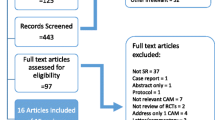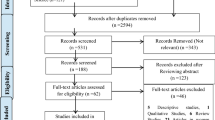Abstract
The objectives of the study were identification, quality evaluation and summary of RCTs on complementary and alternative medicine as defined by the National Institute of Health with the exception of dietary and nutritional supplements. A computerized search of databases from 1990 (year of publication of the ACR criteria for fibromyalgia) to July 2007 was performed. The RCTs were assessed by a methodological quality score. A total of 23 RCTs issued from 1992 to 2007 on acupuncture, balneotherapy, thermotherapy, magnetic therapy, homeopathy, manual manipulation, mind–body medicine, diet therapy and music therapy were identified. The RCTs had an average group size of 25 with the number of groups ranging from two to four. The quality score assessment of the RCTs yielded a mean score of 51 out of 100. The average methodological quality of the identified studies was fairly low. Best evidence was found for balneotherapy/hydrotherapy in multiple studies. Positive results were also noted for homeopathy and mild infrared hyperthermia in 1 RCT in each field. Mindfulness meditation showed mostly positive results in two trials and acupuncture mixed results in multiple trials with a tendency toward positive results. Tendencies for improvement were furthermore noted in single trials of the Mesendieck system, connective tissue massage and to some degree for osteopathy and magnet therapy. No positive evidence could be identified for Qi Gong, biofeedback, and body awareness therapy.
Similar content being viewed by others
Abbreviations
- FMS:
-
Fibromyalgia syndrome
- RCT:
-
Randomized controlled trial
- CAM:
-
Complementary and alternative medicine
- FIQ:
-
Fibromyalgia impact questionnaire
- TP:
-
Tender point
- TPC:
-
Tender point count
- VAS:
-
Visual analog scale
References
Smythe HA, Moldofsky H (1977) Two contributions to the understanding of the ‘fibrositis’ syndrome. Bull Rheum Dis 28(1):928–931
Lautenschläger J, Brückle W, Seglias J, Müller W (1989) Lokasierte Druckschmerzen in der Diagnose der generalisierten Tendomyopathie (Fibromyalgie). Z Rheumatol 48:132–138
Wolfe F, Smythe HA, Yunus MB et al (1990) The American College of Rheumatology 1990 criteria for the classification of fibromyalgia. Report of the Multicenter Criteria Committee. Arthritis Rheum 33(2):160–172. doi:10.1002/art.1780330203
Raspe H, Croft P (1995) Fibromyalgia. Baillieres Clin Rheumatol 9(3):599–614. doi:10.1016/S0950-3579(05)80261-4
Hadler NM (2003) ‘Fibromyalgia’ and the medicalization of misery. J Rheumatol 30(8):1668–1670
Cohen ML (1999) Is fibromyalgia a distinct clinical entity? The disapproving rheumatologist’s evidence. Baillieres Best Pract Res Clin Rheumatol 13(3):421–425. doi:10.1053/berh.1999.0031
Wolfe F, Ross K, Anderson J, Russell IJ, Hebert L (1995) The prevalence and characteristics of fibromyalgia in the general population. Arthritis Rheum 38(1):19–28. doi:10.1002/art.1780380104
Hardy-Pickering R (2007) The use of complementary and alternative therapies for fibromyalgia. Phys Ther Rev 12:249–260. doi:10.1179/108331907X222930
Adams N, Sim J (1998) An overview of fibromyalgia syndrome: mechanisms, differential diagnosis and treatment approaches. Physiotherapy 84:304–318
Abeles AM, Pillinger MH, Solitar BM, Abeles M (2007) Narrative review: the pathophysiology of fibromyalgia. Ann Intern Med 146(10):726–734
Goldenberg DL, Burckhardt C, Crofford L (2004) Management of fibromyalgia syndrome. JAMA 292:2388–2395. doi:10.1001/jama.292.19.2388
Carville SF, Arendt-Nielsen S, Bliddal H et al (2008) EULAR evidence-based recommendations for the management of fibromyalgia syndrome. Ann Rheum Dis 67(4):536–541
University of Texas, School of Nursing, Family Nurse Practitioner Program (2005) Fibromyalgia treatment guideline. University of Texas, School of Nursing, Austin (TX), 13 pp
Noller V, Sprott H (2003) Prospective epidemiological observations on the course of the disease in fibromyalgia patients. J Negat Results Biomed 2:4
Lind BK, Lafferty WE, Tyree PT, Diehr PK, Grembowski DE (2007) Use of complementary and alternative medicine providers by fibromyalgia patients under insurance coverage. Arthritis Rheum 57:71–76
Wahner-Roedler DL, Elkin PL, Vincent A et al (2005) Use of complementary and alternative medical therapies by patients referred to a fibromyalgia treatment program at a tertiary care center. Mayo Clin Proc 80:55–60
Pioro-Boisset M, Esdaile JM, Fitzcharles MA (1996) Alternative medicine use in fibromyalgia syndrome. Arthritis Care Res 9:13–17. doi:10.1002/art.1790090105
National Center for Complementary and Alternative Medicine. What is CAM medicine? NCCAM Publication No. D347. Updated February 2007
Sarac AJ, Gur A (2006) Complementary and alternative medical therapies in fibromyalgia. Curr Pharm Des 12:47–57
Mayhew E, Ernst E (2007) Acupuncture for fibromyalgia–a systematic review of randomized clinical trials. Rheumatology (Oxford) 46(5):801–804. doi:10.1093/rheumatology/kel406
Adams N, Sim J (2005) Rehabilitation approaches in fibromyalgia. Disabil Rehabil 27:711–723. doi:10.1080/09638280400014709
Holdcraft LC, Assefi N, Buchwald D (2003) Complementary and alternative medicine in fibromyalgia and related syndromes. Best Pract Res Clin Rheumatol 17:667–683. doi:10.1016/S1521-6942(03)00037-8
Sierpina VS, Carter R (2002) Alternative and integrative treatment of fibromyalgia and chronic fatigue syndrome. Clin Fam Pract 4(44):853–872
Sim J, Adams N (2002) Systematic review of randomized controlled trials of nonpharmacological interventions for fibromyalgia. Clin J Pain 18:324–336. doi:10.1097/00002508-200209000-00008
Crofford LJ, Appleton BE (2001) Complementary and alternative therapies for fibromyalgia. Curr Rheumatol Rep 3(2):147–156. doi:10.1007/s11926-001-0010-9
Koes B, Bouter L, Beckerman H, van der Heijden G, Knipschild P (1991) Physiotherapy exercises and back pain. BMJ 303:853
Hurwitz EL, Aker PD, Adams AH, Meeker WC, Shekelle PG (1996) Manipulation and mobilization of the cervical spine. A systematic review of the literature. Spine 21:1746–1759. doi:10.1097/00007632-199608010-00007 (discussion 1759–60)
Zheng L, Faber K (2005) Review of the Chinese medical approach to the management of fibromyalgia. Curr Pain Headache Rep 9:307–312. doi:10.1007/s11916-005-0004-9
Ernst E (2006) Acupuncture—a critical analysis. J Intern Med 259:125–137. doi:10.1111/j.1365-2796.2005.01584.x
Kaptchuk TJ (2002) Acupuncture: theory, efficacy, and practice. Ann Intern Med 136:374–383
Liu T (2008) Acupuncture: what underlies needle administration? Evid Based Complement Alternat Med 6(2):185–193
Sprott H (1998) Efficiency of acupuncture in patients with fibromyalgia. Clin Bull Myofascial Pain 3:37–43
Lautenschlaeger J, Schnorrenberger C, Müller W (1989) Akupuntur bei generalisierter Tendomyopathie (Fibromyalgie-Syndrom). Deutsche Zeitschrift für Akupunktur
Sprott H, Mennet P, Stratz T, Müller W (1993) Wirksamkeit der Akupunktur bei Patienten mit generalisierter Tendomyopathie (Fibromyalgie). Aktuelle Rheumatol 132–135. doi:10.1055/s-2008-1047326
Martin DP, Sletten CD, Williams BA, Berger IH (2006) Improvement in fibromyalgia symptoms with acupuncture: results of a randomized controlled trial. Mayo Clin Proc 81(6):749–757
Assefi NP, Sherman KJ, Jacobsen C et al (2005) A randomized clinical trial of acupuncture compared with sham acupuncture in fibromyalgia. Ann Intern Med 143:10–19
Deluze C, Bosia L, Zirbs A, Chantraine A, Vischer TL (1992) Electroacupuncture in fibromyalgia: results of a controlled trial. BMJ 305:1249–1252
Le Bars D, Willer J-C (2002) Pain modulation triggered by high-intensity stimulation: implication for acupuncture analgesia? Int Congr Ser 1238:11–29
Bender T, Karagulle Z, Balint GP et al (2005) Hydrotherapy, balneotherapy, and spa treatment in pain management. Rheumatol Int 25(3):220–224. doi:10.1007/s00296-004-0487-4
Donmez A, Karagulle MZ, Tercan N et al (2005) SPA therapy in fibromyalgia: a randomised controlled clinic study. Rheumatol Int 26:168–172. doi:10.1007/s00296-005-0623-9
Neumann L, Sukenik S, Bolotin A et al (2001) The effect of balneotherapy at the Dead Sea on the quality of life of patients with fibromyalgia syndrome. Clin Rheumatol 20:15–19. doi:10.1007/s100670170097
Evcik D, Kizilay B, Gokcen E (2002) The effects of balneotherapy on fibromyalgia patients. Rheumatol Int 22:56–59. doi:10.1007/s00296-002-0189-8
Altan L, Bingol U, Aykac M, Koc Z, Yurtkuran M (2004) Investigation of the effects of pool-based exercise on fibromyalgia syndrome. Rheumatol Int 24:272–277
Eksioglu E, Yazar D, Bal A, Usan HD, Cakci A (2007) Effects of Stanger bath therapy on fibromyalgia. Clin Rheumatol 26:691–694
Gunther V, Mur E, Kinigadner U, Miller C (1994) Fibromyalgia—the effect of relaxation and hydrogalvanic bath therapy on the subjective pain experience. Clin Rheumatol 573–578. doi:10.1007/BF02242996
Brockow T, Wagner A, Franke A, Offenbacher M, Resch KL (2007) A randomized controlled trial on the effectiveness of mild water-filtered near infrared whole-body hyperthermia as an adjunct to a standard multimodal rehabilitation in the treatment of fibromyalgia. Clin J Pain 23:67–75. doi:10.1097/AJP.0b013e31802b4f80
Ratterman R, Secrest J, Norwood B, Ch’ien AP (2002) Magnet therapy: what’s the attraction? J Am Acad Nurse Pract 14:347–353. doi:10.1111/j.1745-7599.2002.tb00135.x
Cepeda MS, Carr DB, Sarquis T et al (2007) Static magnetic therapy does not decrease pain or opioid requirements: a randomized double-blind trial. Anesth Analg 104:290–294. doi:10.1213/01.ane.0000230613.25754.08
Colbert AP, Markov MS, Banerji M, Pilla AA (1999) Magnetic mattress pad use in patients with fibromyalgia: a randomized double-blind pilot study. J Back Musculoskeletal Rehabil 13:19–31
Alfano AP, Taylor AG, Foresman PA et al (2001) Static magnetic fields for treatment of fibromyalgia: a randomized controlled trial. J Altern Complement Med 7(1):53–64. doi:10.1089/107555301300004538
Bell IR, Lewis DA 2nd, Brooks AJ et al (2004) Improved clinical status in fibromyalgia patients treated with individualized homeopathic remedies versus placebo. Rheumatology (Oxford) 4:577–582. doi:10.1093/rheumatology/keh111
Blunt KL, Rajwani MH, Guerriero RC (1997) The effectiveness of chiropractic management of fibromyalgia patients: a pilot study. J Manipulative Physiol Ther 20:389–399
Gamber RG, Shores JH, Russo DP, Jimenez C, Rubin BR (2002) Osteopathic manipulative treatment in conjunction with medication relieves pain associated with fibromyalgia syndrome: results of a randomized clinical pilot project. J Am Osteopath Assoc 102:321–325
Brattberg G (1999) Connective tissue massage in the treatment of fibromyalgia. Eur J Pain 3(3):235–244. doi:10.1016/S1090-3801(99)90050-2
Kabat-Zinn J (1982) An outpatient program in behavioral medicine for chronic pain patients based on the practice of mindfulness meditation: theoretical considerations and preliminary results. Gen Hosp Psychiatry 4(1):33–47. doi:10.1016/0163-8343(82)90026-3
Sephton SE, Salmon P, Weissbecker I et al (2007) Mindfulness meditation alleviates depressive symptoms in women with fibromyalgia: results of a randomized clinical trial. Arthritis Rheum 57:77–85. doi:10.1002/art.22478
Astin JA, Berman BM, Bausell B et al (2003) The efficacy of mindfulness meditation plus Qigong movement therapy in the treatment of fibromyalgia: a randomized controlled trial. J Rheumatol 30:2257–2262
Mannerkorpi K, Arndorw M (2004) Efficacy and feasibility of a combination of body awareness therapy and qigong in patients with fibromyalgia: a pilot study. J Rehabil Med 36:279–281. doi:10.1080/16501970410031912
Kendall SA, Brolin-Magnusson K, Soren B, Gerdle B, Henriksson KG (2000) A pilot study of body awareness programs in the treatment of fibromyalgia syndrome. Arthritis Care Res 13:304–311. doi:10.1002/1529-0131(200010)13:5<304::AID-ANR10>3.0.CO;2-P
Roxendal G (1985) Body awareness therapy and the body awareness scale. Department of Rehabilitation Medicine, University of Gothenburg, Gothenburg
van Santen M, Bolwijn P, Verstappen F et al (2002) A randomized clinical trial comparing fitness and biofeedback training versus basic treatment in patients with fibromyalgia. J Rheumatol 29:575–581
Keel PJ, Bodoky C, Gerhard U, Muller W (1998) Comparison of integrated group therapy and group relaxation training for fibromyalgia. Clin J Pain 14:232–238. doi:10.1097/00002508-199809000-00010
Azad KA, Alam MN, Haq SA et al (2000) Vegetarian diet in the treatment of fibromyalgia. Bangladesh Med Res Counc Bull 26:41–47
Chesky KS, Russell JI, Lopez Y, Kondraske G (1997) Fibromyalgia tender point pain: a double-blind, Placebo-controlled pilot study of music vibration using the music vibration table. J Musculoskeletal Pain
Colditz GA, Miller JN, Mosteller F (1989) How study design affects outcomes in comparisons of therapy. I: Medical. Stat Med 8(4):441–454. doi:10.1002/sim.4780080408
Schulz KF, Chalmers I, Hayes RJ, Altman DG (1995) Empirical evidence of bias. Dimensions of methodological quality associated with estimates of treatment effects in controlled trials. JAMA 273:408–412. doi:10.1001/jama.273.5.408
Moher D, Jadad AR, Nichol G et al (1995) Assessing the quality of randomized controlled trials: an annotated bibliography of scales and checklists. Control Clin Trials 16:62–73. doi:10.1016/0197-2456(94)00031-W
Juni P, Witschi A, Bloch R, Egger M (1999) The hazards of scoring the quality of clinical trials for meta-analysis. JAMA 282:1054–1060. doi:10.1001/jama.282.11.1054
Berlin JA, Rennie D (1999) Measuring the quality of trials: the quality of quality scales. JAMA 282:1083–1085. doi:10.1001/jama.282.11.1083
Moore RA, Gavaghan D, Tramer MR, Collins SL, McQuay HJ (1998) Size is everything – large amounts of information are needed to overcome random effects in estimating direction and magnitude of treatment effects. Pain 78:209–216. doi:10.1016/S0304-3959(98)00140-7
Author information
Authors and Affiliations
Corresponding author
Additional information
An erratum to this article is available at http://dx.doi.org/10.1007/s00296-009-1120-3.
Rights and permissions
About this article
Cite this article
Baranowsky, J., Klose, P., Musial, F. et al. Qualitative systemic review of randomized controlled trials on complementary and alternative medicine treatments in fibromyalgia. Rheumatol Int 30, 1–21 (2009). https://doi.org/10.1007/s00296-009-0977-5
Received:
Accepted:
Published:
Issue Date:
DOI: https://doi.org/10.1007/s00296-009-0977-5




